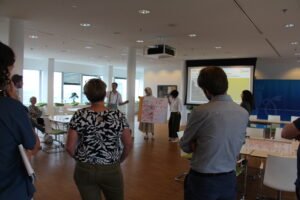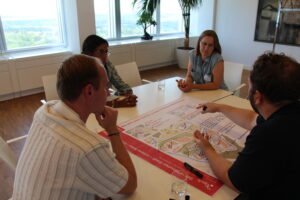What happens when a bold urban vision meets the realities of implementation? This question set the tone for the second CIPU workshop, held on 30 June 2025 in Luxembourg city. Participants returned to the fictional city of Duffereschbourg where they had envisioned living in 2045. But this time, the vision from Workshop 1 gave way to another challenge: how do we make these ideas work in real-world conditions – thinking of available space, cost, policy, and public opinion?
Designing neighbourhoods around everyday needs
Whether the focus of a district in Duffereschbourg was sport and leisure, culture and community, local services, or the link between living and working, participants kept circling back to a few common priorities: flexible and multifunctional spaces, creative reuse of existing buildings, walkable access to everyday services, and ways to involve residents early and meaningfully. Many concepts centred around adaptable and flexible infrastructure – from mobile kitchens and shared logistics hubs to green corridors that double as social spaces. The idea of layering uses onto what already exists came up repeatedly, along with the challenge of making public space not just accessible, but welcoming.

Each group worked on one neighbourhood, developing ideas that were specific to their theme but shaped by these overarching questions: What functions need to be within walking distance? How should public space be designed to support interaction? How do we handle existing structures? And how can participation be built into the process from the beginning – not just as a formality, but as a real source of input and ownership?
What elements make implementation work?
The second part of the workshop introduced a new layer of realism. Participants presented their neighbourhood concepts to fictionalised versions of municipal councils, based on the real dynamics of Luxembourg’s cities and towns. The reactions came quickly – and sounded familiar:
“This already exists.”
“That’s too expensive.”
“It won’t work in our context.”
“People won’t accept that.”

Instead of pushing back, the groups embraced the feedback. They explored how temporary uses and pilot phases could reduce entry barriers. They discussed alternative financing models ranging from cooperatives to project-based partnerships and reflected on how public administrations could establish supportive frameworks rather than automatically rejecting proposals. It became clear that implementing the concept of urban proximity in planning is as much about governance and collaboration as it is about design. It calls for practical creativity: working with existing tools, temporary solutions and testing phases, bridging local interests and finding new ways to activate the public.

A Process, Not a Product
The second workshop continued the step-by-step approach of the CIPU 2025 programme. After imagining a future city in the first Workshop in May, the June workshop focused on translating these ideas into practical neighbourhood concepts and their implementation. It was about exploring what happens when vision meets everyday planning realities by introducing real-world constraints.

The outcomes will now feed into the next stage of the CIPU process: a planning game in October 2025, where the results will be brought to life. A final conference in December will bring together all results, reflections and ideas – with the goal of developing a shared basis for municipalities and stakeholders to bring the 15-minute city concept closer to practice in Luxembourg.
Further documentation will be available soon at www.cipu.lu
Contact and further information
CIPU – Cellule Nationale d’Information pour la Politique Urbaine: cipu@zeyenbaumann.lu
Documentation of the results will be published soon on www.cipu.lu





